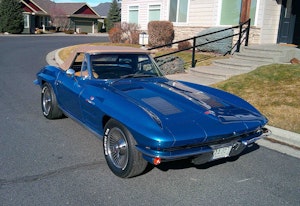Media | Articles
Massive Mopar muscle car trove in South Dakota pays tribute to late collector
A farmer who loved to drive fast, Alan Rietz spent years cultivating a massive collection of classic Mopar muscle cars with his wife’s encouragement. A tragic accident took his life in September, 2017, but his widow and his cars live on to tell the story of a guy who didn’t just say “Mopar or No Car,”—he truly believed it.
Rietz’s vast collection, located near Mansfield, South Dakota, a farming community south of Aberdeen and about 45 miles south of the North Dakota border, was auctioned off on June 9, 2018. Hundreds were in attendance, and untold more online bidders watched from all over. The cloudless day was hot, nearly 100 degrees, and while shady spots offered a respite from the heat, the draw of the cars brought the crowds out into the sun following along with five auctioneers on a flatbed.
The auctioneers started off with a 1970 Dodge Super Bee 440 Six Pack, a car Rietz’s widow, Linda, says was one the cars he had set as a goal to buy.
20180626143205)
20180626143511)
“Alan loved that car because it was a screamer,” Linda recalls. “We took it to area shows and on trips.”
Marketplace
Buy and sell classics with confidence
In great condition and in the stock orange exterior color, the car brought $42,000, the highest sold price among all the cars that day.
Moving down the row of Mopar cars, the auctioneers sold Linda’s 1970 Plymouth Road Runner convertible. This was a car she drove to work all summer with the top down. It has a 440 V-8 out of a cop car and Linda recalls it being incredibly fast. She and her husband found it behind a long-since-closed Chrysler dealer in Mellette, South Dakota.
20180626143626)
20180626143610)
Finding and keeping the Mopars was Alan’s passion, Linda said. She never minded him buying the cars and in fact encouraged it since it made him happy. He enjoyed knowing he was keeping the cars from going to the crusher, and he never sold any of them.
“He never would sell anything, but he would trade with someone,” Linda said. “If he knew that you were going to cut something up, he wouldn’t trade with you. But if you were going to restore it, then he would. People would stop all the time and ask to buy cars and parts, but unless he knew you, the answer was always no.”
Local farmers also wondered what was going to happen to the collection of cars. Sitting in the grass behind his shop, flanked by two farm fields, hundreds of cars had accumulated under Rietz’s appetite for more Mopar.
Since September, VanDerBrink auctions sorted through the collection and narrowed the cars down to the ones they thought they could sell. On the auction day, a total of 51 Challengers, Barracudas, Road Runners, Aspens, Chargers, Dusters, Darts, Furys and one 330 were sold along other cars. In fact, well over a third of the 100+ car auction included Dodge Power Wagons, D100 and D200 Dodge pickups, Ramcharger SUVs and an assortment of other cars like Corvettes and late-model Imperials that Rietz started collecting when Mopar muscle cars starting becoming harder to find.
20180626143405)
Through the years of buying and collecting, often with his good friend Doug Rush, Rietz’s passion for going fast never diminished, even after Rush died. The last car he was working on—a Dodge Aspen powered by a 340 V-8 with a Weiand Hi-Rise intake and other performance modifications—was meant for the drag strip. The not-quite-finished car sold for $6500.
Incredibly, Rietz didn’t just park the cars in the field and forget about it. Nervous about theft, he pulled engines and transmissions out of many of them. Inside the shop, these engines and transmission sat on pallets waiting to be sold. Alongside them were rows of exhaust manifolds, alternators, carburetors, air cleaner covers, water pumps, and more parts. Outside laid bumpers, radiators, grilles, hoods and more. Bidders could literally buy the car they wanted and then buy the parts they wanted to go with it. It was part auction and part swap meet.
When he wasn’t working on cars he farmed the property, creating the income to keep collecting. Linda always wondered if his cars were a big deal or worth anything.
“Alan always said that it wasn’t junk and there were many valuable and desirable cars and parts,” Linda said.
Turns out he was right. The auction brought in hundreds of thousands of dollars, and along with the now-rented-out farmland, Linda shouldn’t have to worry for years to come.
Through it all, those close to Rietz still lament that they can’t all enjoy watching him fly down the drag strip in the Dodge Aspen at least once. Based on their passionately-told stories that are sure to keep his memory alive, we are certain he would have a smile on his face, and Linda would have been there cheering him on.
20180626143458)








20180626143248)
20180626143305)
20180626143354)
20180626143422)
20180626143437)
20180626143531)
20180626143552)
20180626143638)
20180626143701)
20180626143714)
20180626143734)
20180626143744)
20180626143758)
20180626143817)
20180626143837)
20180626143849)
20180626143903)
20180626143918)
20180626144133)
20180626144146)
20180626144158)
20180626144319)
20180626144409)
20180626144501)
20180626144724)
20180626144735)

